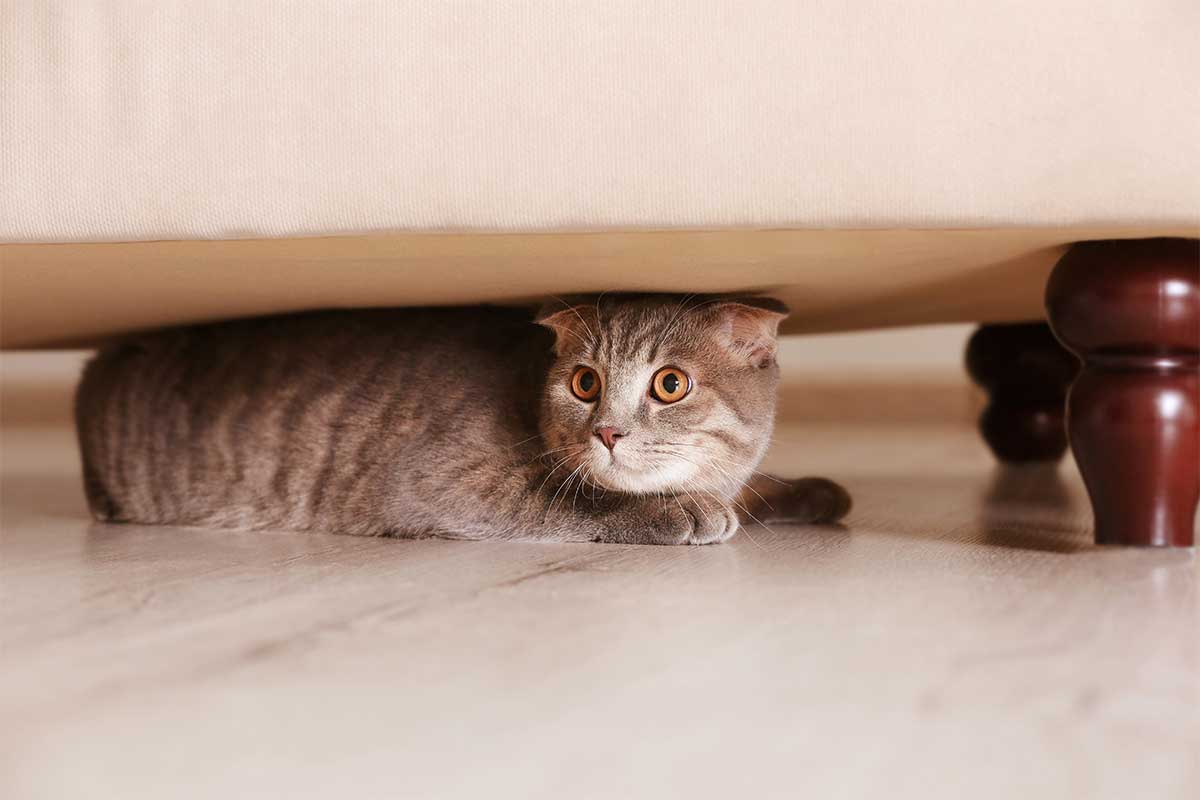When thunderstorms strike, does your cat run and hide under the bed or in the closet? Maybe you notice that she just disappears and you don’t think much about it?
Dogs earn the greatest amount of recognition when it comes to fear of thunderstorms because their reactions are more visible: they tremble, pace, hide, try to escape, house soil, or become disruptive or destructive. We know they’re scared. But cats, too, can be fearful of the atmospheric light and sound shows, reacting to pressure changes, loud wind and rain, and electrical discharges.
“It’s suspected that there are probably more cats bothered by thunderstorms than we realize,” says Debra Horwitz, DVM, DACVB, who practices in St. Louis, Missouri. “They go somewhere they feel safe until the thunderstorm’s over, and since they aren’t bothering the owner in any particular way, they don’t notice it.”
Is that a problem if all cats do in response is hide under the bed? It depends on the severity of the response. If your cat is walking around and during a thunderstorm decides to sit next to you but isn’t trembling or panting, and as soon as the storm’s over he jumps off and does his other stuff, everything may be okay. If your cat goes under the bed in the midst of a window-rattling thunder and lightning storm that makes even you jump, that may be a normal response, not a maladaptive one. Pay attention to how long it takes for your cat to return to normal after a storm. Anxiety and transitory fear aren’t necessarily a problem if your cat bounces back to normal in a relatively short amount of time, Dr. Horwitz says.
But it’s not normal for a cat to spend a lot of time hiding.
“If any animal during a thunderstorm were to decide ‘I feel better in your closet or under the bed’ and when the thunderstorm’s gone they come out [with the attitude] ‘Great, I’m better, that was kind of scary, but I’m over it,’ I would say that’s fine,” Dr. Horwitz says. “If there are thunderstorms in the area and your cat goes under the bed at 8 in the morning and will not come out to eat or use the litter box, even though it’s not storming specifically where you are, that might be maladaptive.”
Cats who seem excessively fearful of thunderstorms can benefit from some of the same tactics and treatments that help dogs.
Veterinary behaviorist Lore Haug, who practices in Sugar Land, Texas, suggests setting up a safe area that is windowless or dark and running a white noise machine or playing music specifically composed to be calming to cats. Good choices include closets, basements, and bathrooms. She also encourages owners to learn some relaxation training techniques that they can do with their cats.
Teach your cat to come when called. In the event of a thunderstorm, tornado, or hurricane, being able to call her and take her to her safe place can prevent a lot of kitty angst.
Natural supplements such as Anxitane, Solliquin, and Zylkene may help as well. They contain ingredients such as l-theanine, milk proteins and other substances that have calming properties but won’t sedate your pet. Start giving the supplement a couple of days before storms start, if possible, following dosage recommendations on the label. You can also give one if a storm comes up unexpectedly. If it works, you may notice that your cat starts to respond less fearfully to storms. You may also want to ask your veterinarian about foods that contain calming ingredients such as L-tryptophan, B vitamins, and hydrolyzed casein.
Cats may respond to a feline pheromone product. Feliway, an artificial version of a pheromone that cats produce to help themselves feel comfortable and secure, is available as a spray or wipe or can be disseminated with a diffuser. Dr. Horwitz recommends spraying the pheromone product in the cat’s safe area.
Calming clothing such as Thundershirts, Storm Defender Capes and Anxiety Wraps can be used with cats, but be careful when putting them on or taking them off. They may have Velcro closures, which can make a loud noise when pulled apart, startling the cat. It’s also possible for the cat’s fur to get caught in the Velcro, making it painful to release him. And some cats respond to the gentle pressure the same way they do to harnesses: they act as if they’re paralyzed and refuse to move. Some cats love them, though, and calm down right away when wearing them. Be sure to put the item on before the storm starts. Some pets may even come and “ask” for it if a storm is in the offing.
“The parameters I would look at would be does the cat spend a lot of time hiding, and is it interfering with the cat’s normal ability to function, not only for health and welfare—eating, drinking, elimination—but in response to interacting with everyone in the household,” Dr. Horwitz says. “If it does, you need intervention.”
This article was reviewed/edited by board-certified veterinary behaviorist Dr. Kenneth Martin and/or veterinary technician specialist in behavior Debbie Martin, LVT.
Kim Campbell Thornton is content manager for Fear Free Pets and is an Elite Fear Free Certified Professional. She has been writing about dogs, cats, wildlife, and marine life since 1985 and is a recipient of multiple awards from the Cat Writers Association, Dog Writers Association of America, and American Society of Journalists and Authors.
Want to stay in the loop on the latest and greatest in keeping your pet happy and healthy? Sign up for our free newsletter by clicking here!








